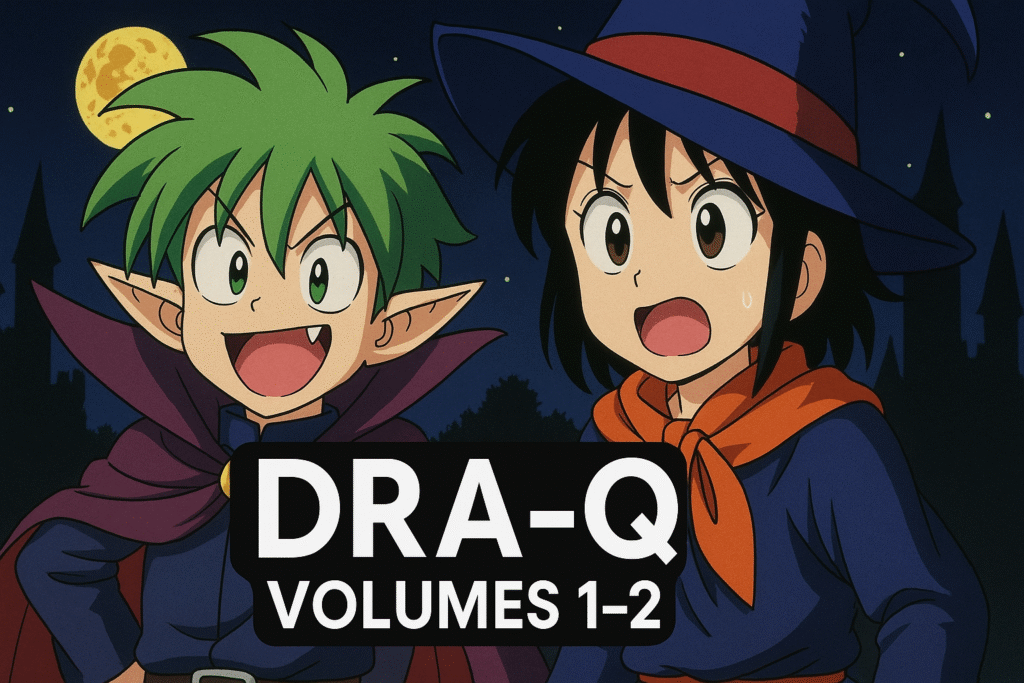Discount Code: Use ANI50 for up to 50 Rs. Discount
Discount Code: Use ANI50 for up to 50 Rs. Discount

Dra-Q Manga Review Volumes 1–2 The world of manga is vast, but every so often a series emerges that dares to redefine genres and expectations. Dra-Q, a relatively new entrant into the seinen-fantasy sphere, does exactly that. With the release of Volumes 1 and 2, Dra-Q is already making waves among fans for its deep world-building, dark tone, and emotionally complex characters. In this spoiler-light but detailed review, we’ll dive into what makes these first two volumes compelling, the story so far, and why this series might be the next big thing for fantasy manga enthusiasts.
Dra-Q unfolds in a dystopian future where dragons are not just mythological beings—they are tyrannical rulers. The Earth, or what’s left of it, is now a fragmented continent known as Draconia. After the Dragon Ascension War, humanity has become a subservient species, forced into labor camps and underground cities to survive.
Technology has regressed in the outer zones, while the inner sanctums—reserved for dragon loyalists—thrive in biomechanical cities powered by dragon essence. This sharp contrast serves as a recurring theme throughout the manga: disparity, control, and the thin line between beast and human.
Volume 1 introduces us to Kai Rengoku, a teenage smuggler born in the underbelly of Sector 9, one of the last human settlements not directly controlled by the dragons. Haunted by the memory of his sister’s execution at the hands of a dragon general, Kai is bitter, sharp-tongued, and distrustful of everyone. But he’s also resourceful and hides a mysterious ability that seems to disrupt dragon essence.
The story begins with a failed heist. Kai and his crew attempt to intercept a shipment of “scale dust,” a substance derived from dragon skin that’s used to power weapons. The mission ends in disaster when a dragon enforcer named Vetharion ambushes them. The pages here are intense—artistically explosive panels depict the raw strength of Vetharion, emphasizing how fragile humanity truly is.
Kai narrowly escapes, but not before he activates a strange relic left behind by his mother—a shard of a dragon’s heart. The shard bonds with him, granting him increased strength, agility, and most intriguingly, a faint echo of the dragon’s voice inside his mind.
Volume 1 ends with Kai captured by a resistance cell known as the Ashen Talons, a rag-tag group of former soldiers, scholars, and rogue dragons who believe that a half-dragon like Kai could be the key to reversing humanity’s fate.
Volume 2 deepens the lore and focuses on character development. We’re introduced to several key members of the Ashen Talons:
Kai’s training begins here—not just in combat but in history, ideology, and the truth about the dragons. Through flashbacks and hidden archives, we learn that dragons were once protectors of Earth, created by the Ancients to maintain balance. Something changed during the Ascension War—a virus, a betrayal, or something deeper—and now their roles have flipped.
Meanwhile, Vetharion is promoted to Prime Wing Commander and begins hunting Kai with brutal efficiency. He suspects that Kai’s heart-shard is part of the Echo Matrix, an ancient device rumored to be able to either control or destroy all dragons.
The climax of Volume 2 is a major turning point: a skirmish in the ruins of Eido Tower, where Kai uses his developing powers to shield the Talons from a coordinated dragon assault. The battle is beautifully illustrated—fiery wings, shattered buildings, and emotionally raw decisions dominate the panels.
Kai chooses to spare a young dragonling, much to the dismay of Lyra, signaling a shift in his moral compass. This choice complicates the narrative, moving it beyond simple revenge to themes of coexistence, transformation, and inherited guilt.
The art of Dra-Q is undeniably one of its strongest points. The illustrator, credited only as “Seko,” blends traditional ink with digital overlays, creating a gritty yet fantastical aesthetic. Cities are drawn with staggering detail—towering ruins, broken statues of gods, mechanical veins running through skyscrapers.
Dragons are designed not as elegant or mythical beings, but biomechanical monstrosities with armor-like scales, pulsing veins of essence, and luminous eyes. Each one has a distinct design and aura, making them feel more like ancient gods than mere beasts.
Tone-wise, Dra-Q is dark but not nihilistic. It doesn’t shy away from depicting the horrors of oppression, loss, or moral compromise. However, hope lingers in its characters, in quiet moments of reflection and humor. It’s not grimdark—it’s grounded.
What elevates Dra-Q beyond a typical rebellion story are its philosophical underpinnings:
Volumes 1 and 2 of Dra-Q are an explosive beginning to what promises to be a profound and thrilling series. With a richly built world, emotionally complex characters, and timely themes, the manga doesn’t just entertain—it challenges.
Whether you’re in it for the action, the lore, or the emotional arcs, Dra-Q delivers on all fronts. We highly recommend picking it up and keeping an eye on future volumes.
Have you read Dra-Q? What did you think of Kai’s decision at Eido Tower? Share your thoughts in the comments!
Solo Leveling Season 2 Episode 5: Release Date, Story, and Review
Solo Leveling Season 2 Episode 4: What to Expect


Detective Conan Anime’s 1-Hour “Episode Zero” Special: A New Chapter Begins
Dra-Q Volumes 1–2 Manga Review: A Daring Tale of Dragons, Dystopia, and Discovery
Ninja and an Assassin Under One Roof – Episode 6 Recap and Review
Black Butler: Emerald Witch Arc — Season Premiere Recap and Review
Solo Leveling Season 2 Episode 13: The War Against the Monarchs Begins!
Solo Leveling Season 2 Episode 12: The Battle Reaches Its Peak!
